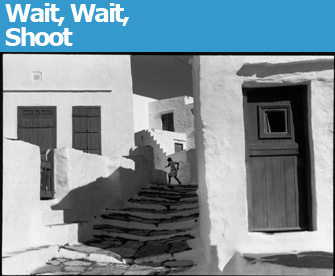 |
|
“Sifnos, Greece” (1961) © Henri Cartier-Bresson/Magnum Photos |
Ho-hum, you might think, another exhibition of photos by Henri Cartier-Bresson, but that would be very wrong thinking. Cartier-Bresson (1908-2004) was such a master of his genre that his …
 |
|
“Sifnos, Greece” (1961) © Henri Cartier-Bresson/Magnum Photos |
Ho-hum, you might think, another exhibition of photos by Henri Cartier-Bresson, but that would be very wrong thinking. Cartier-Bresson (1908-2004) was such a master of his genre that his timeless images always bear revisiting.
Seeing the photos in the exhibition “Henri Cartier-Bresson: L’Imaginaire d’après Nature” (through September 13) at the Musée d’Art Moderne de la Ville de Paris takes us back to the source at a time when photographers have to resort to all kinds of high-tech and artistic manipulation to hold our attention. There’s nothing at all wrong with using special effects in art photography, of course, but it is still amazing to see what HCB, as the French call him, was able to do with absolutely no posing, gimmicks, high-speed shooting or cropping. His brilliant compositions were formed on the spot at the instant the picture was taken. He just looked, waited and shot. As he put it himself (he was also one of those rare artists who was able to speak and write intelligently about his work and his methods), his technique was to “wait, wait, shoot.”
His patience was amply rewarded. One can only wonder at how he captured a fruit vendor sitting under a chalk drawing of a profile that perfectly echoes the man’s despairing pose and even the shape of his features. Almost every image in the show is arresting, some of them very well-known and others less so: a blurred cyclist, for example, seen from above as he speeds down a cobblestoned road at the foot of a spiral staircase in Hyères, France; or two figures framed in wooden rectangles in the arena in Valencia, Spain: an out-of-focus boy hidden in the shadows and a stern-looking guard in the foreground, one eyepiece of his round spectacles reflecting the sun.
When HCB photographed a major public event, he never went after the main action but told the story through the reactions of people present: what could be more telling than the skeptical expressions on the faces of the old ladies listening to a speech by Charles de Gaulle in 1961? At a football match at West Point, we don’t see the game, but some pretty girls flirting with caped cadets. And what could be more suggestive of an era than a 1960 shot of a man sitting behind his desk in an office looking up as a presumed secretary enters; all we see of the secretary is her shapely uplifted leg. I could go on describing individual photos, but better to see them than read about them.
This show is a re-creation of a traveling exhibition put together in 1975, the year HCB gave up photography definitively to devote himself to drawing and painting. He chose himself the 68 images, which offer an overview of his 40-year career as a photographer. These are the original prints from that show, which were not made by Cartier-Bresson himself. They are larger than we are accustomed to seeing and are not framed under glass, allowing us to look at them as they should be seen, without reflections. While the pictures were originally shown in no particular order, the curators of this exhibition have found pleasing echoes among them and divided them into groups covering early works, major events, daily life and portraits.
Cartier-Bresson has a lot to answer for. Looking at his photos gives one a powerful urge to become a photographer, and today the world is awash with the inferior productions of wannabe HCBs. More fortuitously, his influence can also be seen in the work of many leading photographers who have learned from the master without imitating him. One example is William Eggleston, whose work was recently shown at the Fondation Cartier in Paris. Eggleston works in much the same way as HCB, without set-ups, tricks or cropping, but has added his wonderful sense of color to the equation.
Musée d’Art Moderne de la Ville de Paris: 11, avenue du Président Wilson, 75116 Paris. Métro: Alma-Marceau or Iéna. Tel.: 01 53 67 40 00. Open Tuesday-Sunday, 10 a.m.-6 p.m. (Thursday until 10 p.m.). Closed on Mondays and public holidays. Admission: €6.00. Through September 13. www.mam.paris.fr
Buy related books and films from the Paris Update store.
More reviews of current art exhibitions.
Reader reaction
Click here to respond to this article (your response may be published on this page and is subject to editing).
© 2009 Paris Update
Favorite